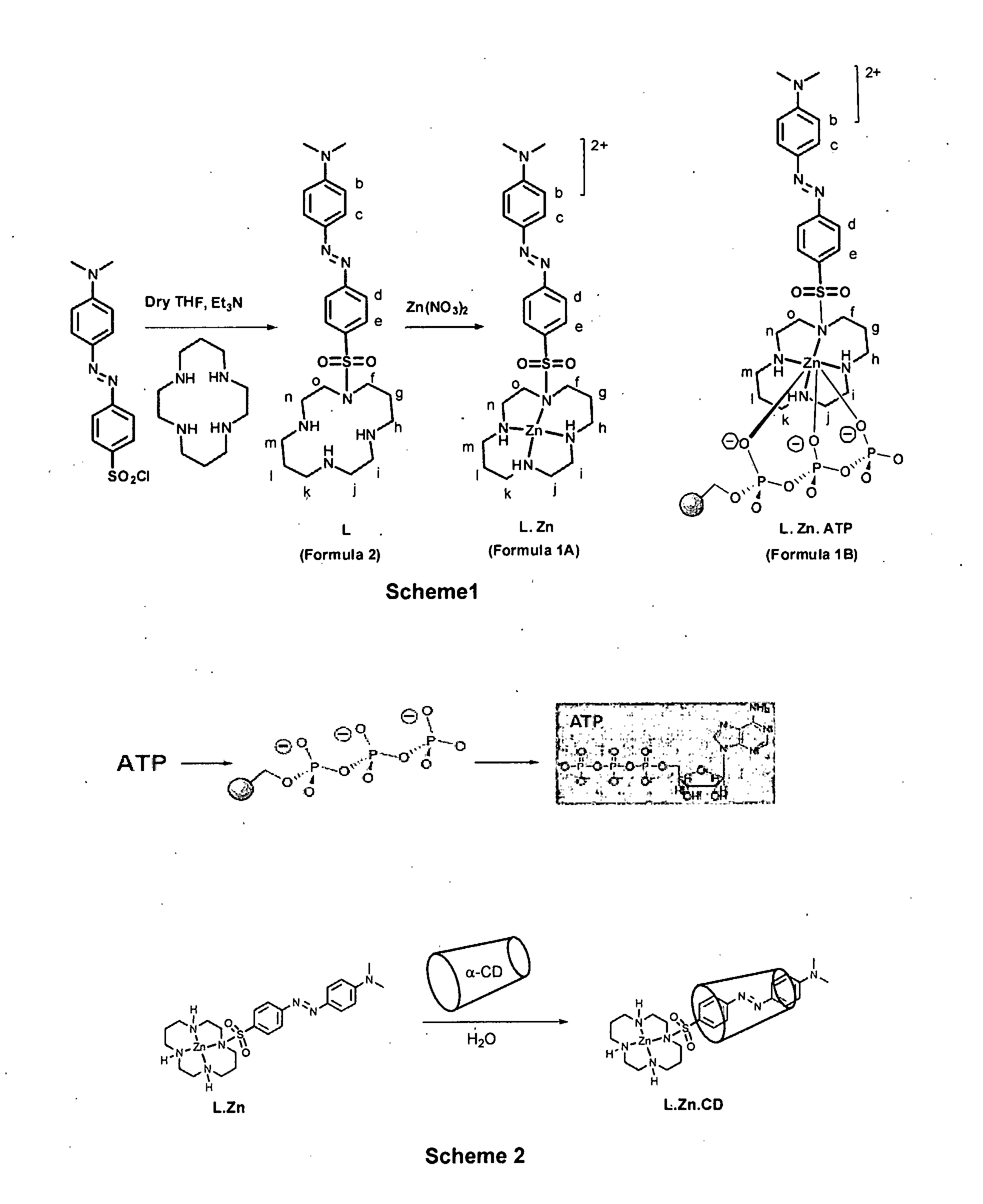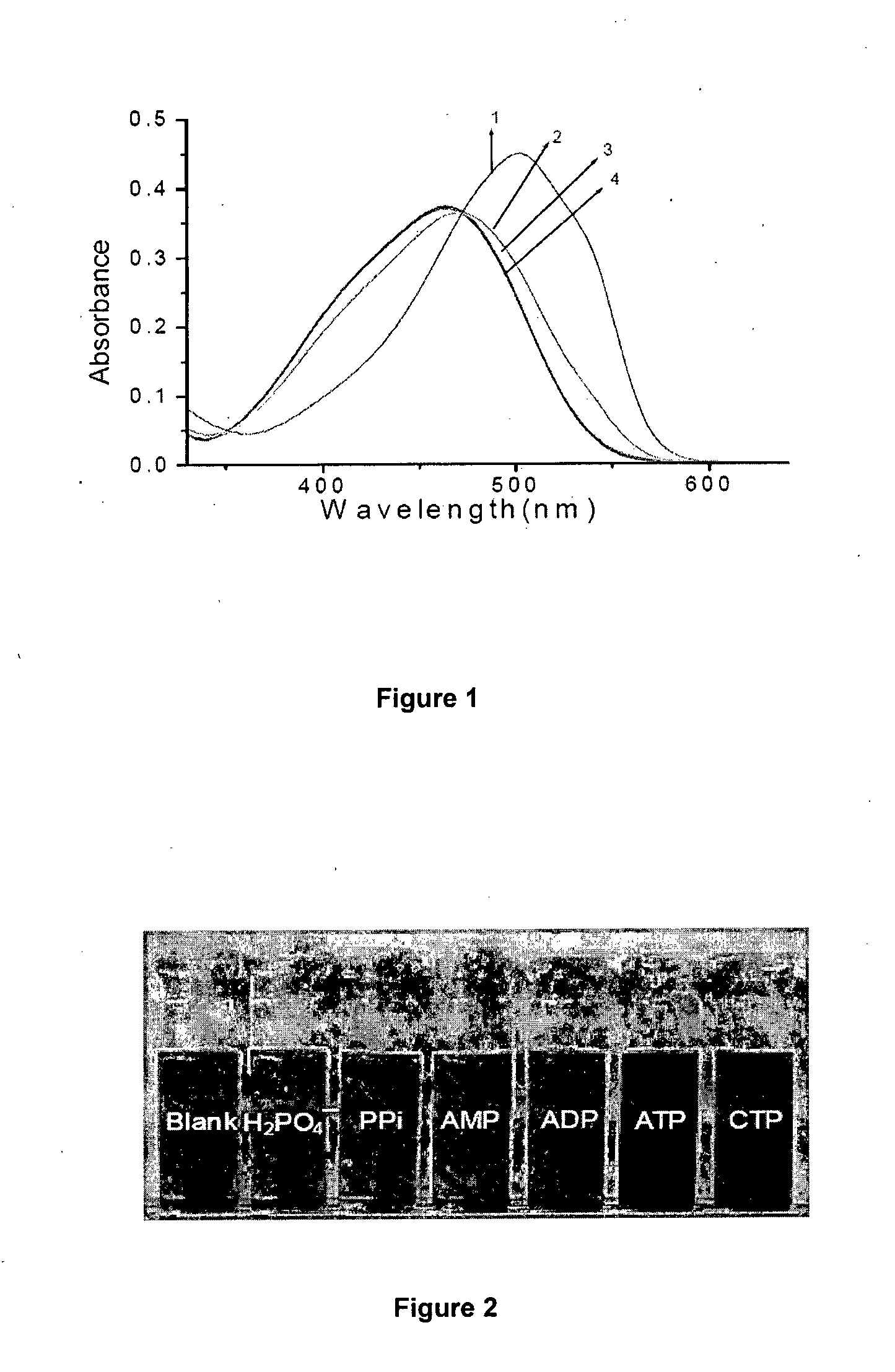Zn (II) based colorimetric sensor and process for the preparation thereof
- Summary
- Abstract
- Description
- Claims
- Application Information
AI Technical Summary
Benefits of technology
Problems solved by technology
Method used
Image
Examples
example 1
[0201]In a 250 mL capacity round bottom flask, 247 mg (1.23 mM concentration) of 1,4,8,11 tetraazacyclotetradecane (cyclam) was dissolved in 100 mL dry tetrahydrofuran (12.3 mM concentration) under mild stirring at 25° C. The flask with the solution was kept in ice at a temperature of 5° C. was maintained. To this 5 mL of triethylamine was added at 1.0 mL / min. A separately prepared solution containing 400 mg of 4-(4′-dimethylamino phenyl azo) benzene sulphonyl chloride in 50 mL tetrahydrofuran (24.76 mM concentration) was added at 50 mL / hour under stirring and at temperature of 5° C. The mixture after attaining the temperature of 25° C. was stirred for 6 hours and then refluxed for 30 minutes. The filtered and washed precipitate (ligand) was dissolved in methanol at 25° C. to have a concentration of 15 mM. To this Zinc nitrate solution of 0.5 mole equivalent of the ligand was added at a temperature of 25° C. and kept stirring for a period of 15 hours. The temperature of resulting mi...
example 2
[0204]In a 250 mL capacity round bottom flask, 247 mg (1.23 mM concentration) of 1,4,8,11 tetraazacyclotetradecane (cyclam) was dissolved in 154 mL dry tetrahydrofuran (8.0 mM concentration) under mild stirring at 25° C. The flask with the solution was kept in ice at a temperature of 5° C. was maintained. To this 5 mL of triethylamine was added at 1.0 mL / min. A separately prepared solution containing 400 mg 4-(4′-dimethylamino phenyl azo) benzene sulphonyl chloride in 50 mL tetrahydrofuran (24.76 mM concentration) was added at 50 mL / hour under stirring and at temperature of 5° C. The mixture after attaining the temperature of 25° C. was stirred for 6 hours and then refluxed for 30 minutes. The filtered and washed precipitate (ligand) was dissolved in methanol at 25° C. to have a concentration of 15 mM. To this Zinc nitrate solution of 0.5 mole equivalent of the ligand was added at a temperature of 25° C. and kept stirring for a period of 15 hours. The temperature of resulting mixtur...
example 3
[0207]In a 250 mL capacity round bottom flask, 247 mg (1.23 mM concentration) of 1,4,8,11 tetraazacyclotetradecane (cyclam) was dissolved in 100 mL dry dichloromethane (12.3 mM concentration) under mild stirring at 25° C. The flask with the solution was kept in ice at a temperature of 5° C. was maintained. To this 5 mL of triethylamine was added at 1.0 mL / min. A separately prepared solution containing 400 mg 4-(4′-dimethylamino phenyl azo) benzene sulphonyl chloride in 50 mL dry dichloromethane (24.76 mM concentration) was added at 50 mL / hour under stirring and at temperature of 5° C. The mixture after attaining the temperature of 25° C. was stirred for 6 hours and then refluxed for 30 minutes. The filtered and washed precipitate (ligand) was dissolved in methanol at 25° C. to have a concentration of 15 mM. To this Zinc nitrate solution of 0.5 mole equivalent of the ligand was added at a temperature of 25° C. and kept stirring for a period of 15 hours. The temperature of resulting m...
PUM
 Login to View More
Login to View More Abstract
Description
Claims
Application Information
 Login to View More
Login to View More - R&D
- Intellectual Property
- Life Sciences
- Materials
- Tech Scout
- Unparalleled Data Quality
- Higher Quality Content
- 60% Fewer Hallucinations
Browse by: Latest US Patents, China's latest patents, Technical Efficacy Thesaurus, Application Domain, Technology Topic, Popular Technical Reports.
© 2025 PatSnap. All rights reserved.Legal|Privacy policy|Modern Slavery Act Transparency Statement|Sitemap|About US| Contact US: help@patsnap.com



